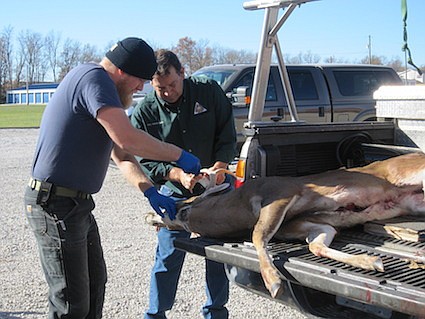
On a sunny Saturday morning at Central Missouri Meat and Sausage just outside of Fulton, hunters decked out in camouflage lined up trucks dropping off their deer for processing. While they were there, many of them opted to have the carcasses tested for Chronic Wasting Disease (CWD), a neurological disease that has been found in deer populations around Missouri but has yet to be detected in Callaway County.
"It seems to be less about a concern over CWD and more about an appreciation of what the department is trying to do by sampling the animals," said Bruce Henry, natural history biologist for the Missouri Department of Conservation (MDC).
"I really just brought it (the deer) in to get it made into sausage," said Lauren Gibson, a 25-year-old woman who has been deer hunting all her life. "But since they (MDC) are here, I figured I'd go ahead and let them test it."
One man, however, specifically brought his animal for testing on Saturday morning before taking it home to dress it himself.
Currently, testing in Callaway County is voluntary and is being used solely to monitor the health of the local wild deer population. It's a fairly quick process as MDC personnel cut through the throat of the animal to remove the lymph nodes. Then using a gridded map, they ask hunters to show where the deer was killed. It will take three to four weeks to finalize the test results, but hunters can access the information online with their Conservation ID number.
"We're glad to have them here," Cory Hawkins, one of the owners of Central Missouri Meat and Sausage, said of the MDC testing station that was set up for a two-weekend period in mid-November. "And we welcome the hunters, even if they take their deer home to process it."
Hawkins says that he has "no concerns at all" over health risks from CWD. He just thinks it's a good program that supports keeping the deer populations strong.
During the 2014 - 15 season, hunters in Missouri brought in a total of 258,341 deer, according to an MDC harvest report. The opening weekend of last year's firearms season, Callaway County was in the top three counties to bring down deer. That's a lot of venison on the tables for Missouri families.
Hunters have not only fed their own, but through the Share the Harvest program, they have also donated thousands of pounds of venison to other families who might be hungry.
Share the Harvest began in 1992 when archers in Missouri decided to donate some of the meat they harvested to those in need. From then on, MDC and the Conservation Federation of Missouri partnered up to sponsor the program. Last year, Central Missouri Region deer hunters donated 39,000 pounds of venison to the hungry, and of that total, 5,640 pounds came from Callaway County hunters.
At this point, there is no evidence that CWD can be transferred to humans, and according to the Center for Disease Control (CDC), a connection between CWD and the variant Creutzfeldt-Jakob disease (vCJD), which is a similar illness found in humans, is unknown.
According to a 2004 CDC report, there have been a handful of anecdotal cases where humans with vCJD may have been exposed to infected deer, but their final conclusion after lengthy investigations is that the "risk, if any, of transmission of CWD to humans is low." However, they go on to say that hunters should consult with their state wildlife agencies and understand where the disease has been found.
It is also important to note that deer may not show symptoms of CWD until it has been in their systems for up to 18 months. Yet the deer can be infectious to its environment and other deer immediately after being exposed to the disease.
The CDC recommends humans avoid eating meat from deer and elk that look sick or test CWD positive. They also recommend wearing gloves when field-dressing carcasses and that hunters bone-out meat from the animal and minimize the handling of brain and spinal cord tissues.
The MDC also asks that hunters who bring down deer in one of the 19 management zone counties-which Callaway County has been named this year- not "take whole deer carcasses, or carcasses that contain brain, spinal cord, eyes, spleen or lymph nodes, out of the counties."
And if a carcass is moved, it is recommended that these parts be double-bagged and placed in the garbage or left for a deer processor to handle.
"We're doing our best as a department to educate the citizens," Callaway County Conservation Agent Steve Kistner wrote in a recent email. He also added that anyone with questions concerning CWD in Missouri is welcome to contact him at 573-239-8129. For testing sites, hunters may refer to the MDC 2015 Fall Deer & Turkey Hunting Regulations and Information booklet.

